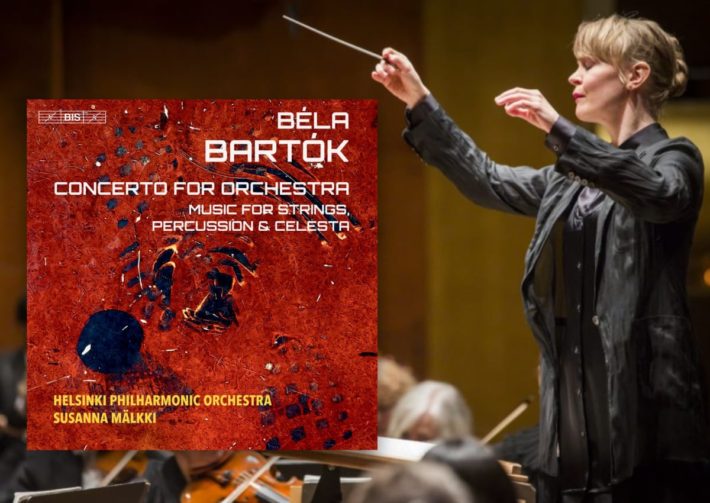Image: ©️ Chris Lee
Susanna Mälkki and her Helsinki orchestra continue their exploration of Bartók’s orchestral works in this new release. The two previous recordings – “The Wooden Prince” and “The Miraculous Mandarin” Suites (May 2019) and Bluebeard’s Castle (April 2021) – garnered a great deal of positive press, so I was especially eager to hear their performances of these two masterpieces, written in the final decade of Bartók’s life.
Orchestral execution in both works is superb: strings play with enviable unanimity and a broad variety of colors and hues. Sample the sinewy and muted timbre heard in the first movement of the Music for Strings, Percussion & Celesta (MSPC), and then the laser focused, brightly lit colors in the following Allegro. They dispatch Bartok’s angular writing with impressive agility, and I greatly enjoyed the ferocity used in the music’s many pizzicato passages.
Mälkki and the BIS engineers ensure the harp is well positioned within the orchestral balance, which highlights the sophistication of Bartók’s orchestration – a wonderful example is heard at 2’45” in the second movement of Music for Strings, Percussion & Celesta. Solo woodwinds have plenty of character, while the ensemble wind choir is immaculately tuned and wonderfully balanced, allowing countermelodies often lost in other recordings to be clearly heard. The brass play with sharp attacks, wedded to fulsome richness, the second and final movements of the Concerto particularly brilliant. Polyphonic writing in both works is clearly delineated, as are the instrumental groupings in Music for Strings, Percussion & Celesta. The Helsinki Philharmonic has always been an admirable ensemble, but their releases over the last decade, featuring a wide array of repertoire, show them to be one of the finest orchestras in Europe.
So, everything seems in place for an exceptional album: an intelligent and sensitive conductor leading a fabulous orchestra, recorded in super-audio BIS sound. Yet, frustratingly, I came away impressed but unmoved. There are several moments in these performances where the music has been tamed when it should be wilder. The final movement of Music for Strings, Percussion & Celesta is a particularly apt example: Mälkki takes 7’32”, whereas Solti’s reading is 6’35” and Kocsis’ comes in at 6’27”. But it is not merely an issue of faster tempos – both Solti and Kocsis drive the music harder, at times allowing it to seem on the verge of coming off the rails. This creates an ‘edge of your seat’ energy that is lacking in this new performance. Solti’s Chicagoans play with razor-sharp attack and astounding virtuosity, following his shaping and rubato perfectly. And Kocsis management of the manic changes in mood and temperament is unbeatable. The Finnish performance just operates at a lower emotional temperature.
Related Classical Music Reviews
- Review: Amman, Ravel, Bartók – Haefliger
- Review: Bartók – Concerto for Orchestra, Suite 1 – Dausgaard
- Review: Bartók String Quartets (Complete) – Quatuor Diotima
Mälkki’s approach pays greater dividends in the slow movements. She finds a genuinely unnerving atmosphere in the MSPC’s first movement. The night music of the Concerto’s third movement is another highpoint, it’s moody and unsettling atmosphere haunting the memory long after the music ends. And the Concerto’s “Intermezzo” is particularly affecting, because Mälkki creates a more maudlin mood in the slower sections, so that the sudden disruption of distorted march music (with fabulous trombone slides at 2’20”) feels even more grotesque.
Tempos are also a concern. There are several instances in which Mälkki is a few notches under the composer’s metronome marking, whereas Reiner, Solti, Fischer and Kocsis honor those markings more closely. Moreover, tempo relationships between sections in a movement are sometimes unconvincing. A clear example is heard in the final minutes of the concerto’s last movement: at 8’46” Mälkki really pulls the tempo back, probably intending to give the brass chorale even more room to build, while allowing the melismatic string passage to sound more cleanly. But the energy built-up from the previous section dissipates. She does the same thing in the final measures as the last statement of the theme is sounded by the brass, accompanied by well-manicured running figures in the woodwinds and strings. But turn to Fischer and Kocsis and the same passage has far greater momentum, a wilder and more exultant ending that is surely what Bartók intends.
Liner notes, by Arnold Whittall, are exemplary and BIS’s SACD sound lets us hear every nuance of Bartók’s incredible scores. If the older readings by Fischer, Solti and Kocsis strike some listeners as overwrought, this fine new recording may be just the thing.

Bartók: Concerto for Orchestra and Music for String Percussion & Celesta
Helsinki Philharmonic Orchestra
Susanna Mälkki – Conductor
BIS Records, SACD 2378
Recommended Comparisons
Read more classical music reviews or visit The Classic Review Amazon store
Follow Us and Comment:
Get our periodic classical music newsletter with our recent reviews, news and beginners guides.
We respect your privacy.









